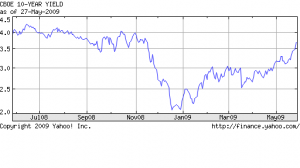Markets Will Ultimately Determine Long Term Interest Rates
Treasuries continued their sell off today as the yield on the 10 year benchmark bond climbed to 3.72%, a stunning increase from the recent lows just over 2% in late 2008. Investors have become concerned that record amount of debt sales and quantitative easing by the Treasury that may lead to inflation.

10 Year Treasury
Courtesy Yahoo Finance
Further contributing to the huge bond selloff today were comments by Marc Faber that the US might enter “hyperinflation” based on the Fed’s super low rate policy, huge increases in government debt and massive liquidity injections into the banking system.
Mortgage Rates Explode Upward
The yield on the 10 year bond has been climbing since early January, gradually putting pressure on mortgage rates. Until recently mortgage rates did not jump dramatically since the spread between the 30 year fixed rate mortgage and the 10 year treasury narrowed.
Some analysts have speculated that the Fed was able to manipulate mortgage rates lower over the short term through purchases of mortgage backed securities. Today, the Fed discovered the limits of establishing artificial price points. The Fed may be able to manipulate rates in the short term, but the markets will ultimately set the price of money based on the reality of US financial conditions.
Bloomberg – The difference between yields on Fannie Mae’s current- coupon 30-year fixed-rate mortgage bonds and 10-year Treasuries had been narrowing. It was at 0.92 percentage point today, down from as high as 2.38 percentage points in March 2008, according to Bloomberg data. The Fed’s purchases drove the spread to 0.70 percentage point, the lowest since 1992, on May 22. The yield gap jumped from 0.71 percentage point yesterday.
“Many investors who felt MBS spreads were too tight thought it might be time to take chips off the table,” Credit Suisse’s Swaminathan said. “This is something we anticipated would build up” as many mortgage-bond holders who were previously wary of lightening their positions on the view the Fed buying would continue to support the market finally decided to act.
“The last two months have been quite abnormal” as mortgage rates generally held in a range between 4.5 percent and 4.75 percent even while Treasury yields began climbing, he said.
Today, the “abnormal” pricing situation was shredded. Major banks sent out multiple mortgage rate increase notices as the day progressed. Here’s an example of how mortgage rates have increased with one large bank over the past couple of days.
Mortgage Rates In The 4% Range Disappear
On Thursday, May 21st, a prime mortgage borrower could have obtained a 30 year fixed rate of 4.75% with a half point fee. On May 27, the equivalent rate for a prime borrower is 5.375% with a half point fee.
To obtain the 4.75% rate today, a borrower would need to pay approximately $5,400 on a $250,000 loan to buy the 4.75% rate. The monthly payment difference on a $250,000 mortgage loan at 5.375% vs. 4.75% amounts to $96 or $1152 per year.
Are 6% 30 Year Fixed Rate Mortgages Coming Soon?
So much for Mr. Bernanke’s grand experiment of buying mortgage debt with printed money. If the spread between mortgage bonds and the 10 year treasury widen to the spread of 238 basis points seen in March 2008, the 30 year mortgage rate will be over 6%, even if the 10 year treasury remains at 3.72%.